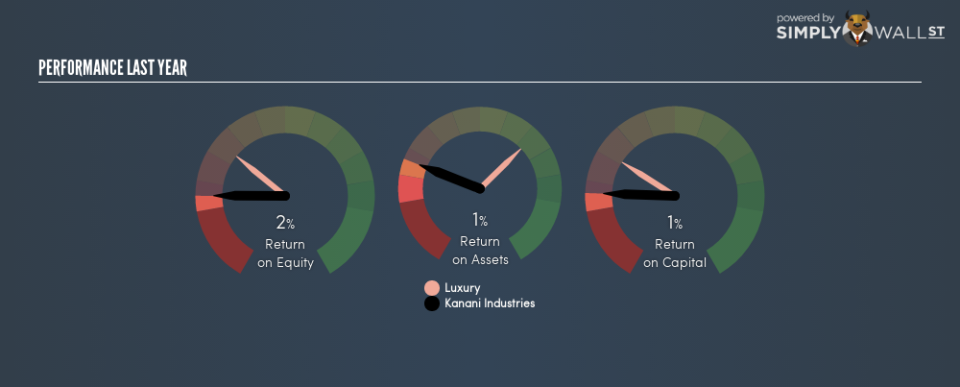Is Kanani Industries Limited (NSE:KANANIIND) Investing Your Capital Efficiently?

Today we’ll evaluate Kanani Industries Limited (NSE:KANANIIND) to determine whether it could have potential as an investment idea. In particular, we’ll consider its Return On Capital Employed (ROCE), as that can give us insight into how profitably the company is able to employ capital in its business.
Firstly, we’ll go over how we calculate ROCE. Next, we’ll compare it to others in its industry. Then we’ll determine how its current liabilities are affecting its ROCE.
What is Return On Capital Employed (ROCE)?
ROCE is a metric for evaluating how much pre-tax income (in percentage terms) a company earns on the capital invested in its business. In general, businesses with a higher ROCE are usually better quality. Overall, it is a valuable metric that has its flaws. Author Edwin Whiting says to be careful when comparing the ROCE of different businesses, since ‘No two businesses are exactly alike.’
How Do You Calculate Return On Capital Employed?
The formula for calculating the return on capital employed is:
Return on Capital Employed = Earnings Before Interest and Tax (EBIT) ÷ (Total Assets – Current Liabilities)
Or for Kanani Industries:
0.014 = ₹7.7m ÷ (₹1.6b – ₹1.1b) (Based on the trailing twelve months to March 2018.)
Therefore, Kanani Industries has an ROCE of 1.4%.
Check out our latest analysis for Kanani Industries
Does Kanani Industries Have A Good ROCE?
ROCE is commonly used for comparing the performance of similar businesses. In this analysis, Kanani Industries’s ROCE appears meaningfully below the 11% average reported by the Luxury industry. This performance is not ideal, as it suggests the company may not be deploying its capital as effectively as some competitors. Independently of how Kanani Industries compares to its industry, its ROCE in absolute terms is low; especially compared to the ~7.6% available in government bonds. There are potentially more appealing investments elsewhere.
Kanani Industries’s current ROCE of 1.4% is lower than its ROCE in the past, which was 5.1%, 3 years ago. Therefore we wonder if the company is facing new headwinds.
When considering ROCE, bear in mind that it reflects the past and does not necessarily predict the future. ROCE can be deceptive for cyclical businesses, as returns can look incredible in boom times, and terribly low in downturns. ROCE is, after all, simply a snap shot of a single year. How cyclical is Kanani Industries? You can see for yourself by looking at this free graph of past earnings, revenue and cash flow.
Do Kanani Industries’s Current Liabilities Skew Its ROCE?
Short term (or current) liabilities, are things like supplier invoices, overdrafts, or tax bills that need to be paid within 12 months. Due to the way ROCE is calculated, a high level of current liabilities makes a company look as though it has less capital employed, and thus can (sometimes unfairly) boost the ROCE. To check the impact of this, we calculate if a company has high current liabilities relative to its total assets.
Kanani Industries has total assets of ₹1.6b and current liabilities of ₹1.1b. Therefore its current liabilities are equivalent to approximately 66% of its total assets. This is a fairly high level of current liabilities, boosting Kanani Industries’s ROCE.
The Bottom Line On Kanani Industries’s ROCE
Kanani Industries’s ROCE in absolute terms is poor, and there are likely better investment prospects out there. You might be able to find a better buy than Kanani Industries. If you want a selection of possible winners, check out this free list of interesting companies that trade on a P/E below 20 (but have proven they can grow earnings).
For those who like to find winning investments this free list of growing companies with recent insider purchasing, could be just the ticket.
To help readers see past the short term volatility of the financial market, we aim to bring you a long-term focused research analysis purely driven by fundamental data. Note that our analysis does not factor in the latest price-sensitive company announcements.
The author is an independent contributor and at the time of publication had no position in the stocks mentioned. For errors that warrant correction please contact the editor at editorial-team@simplywallst.com.

